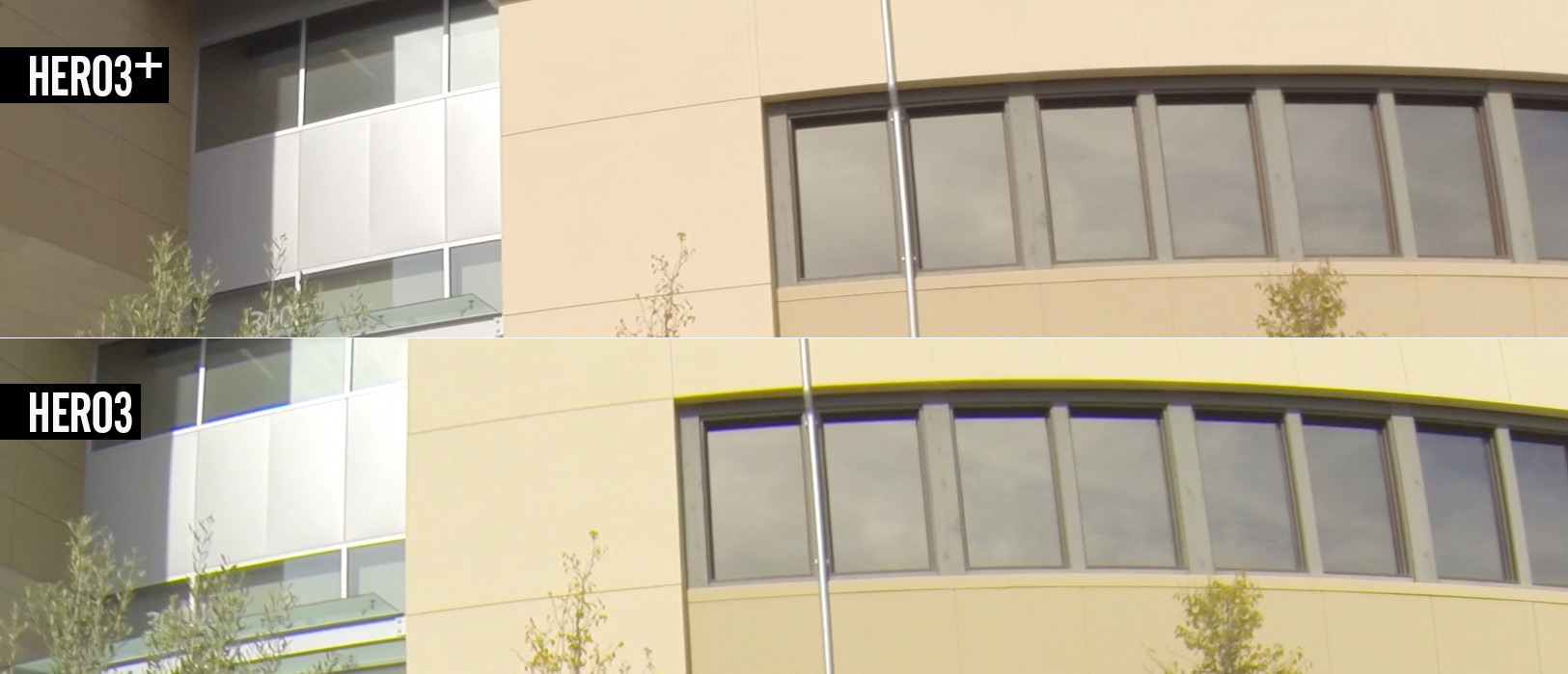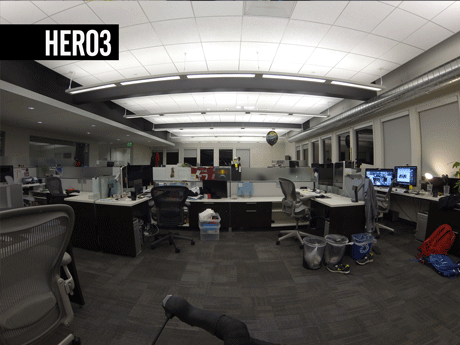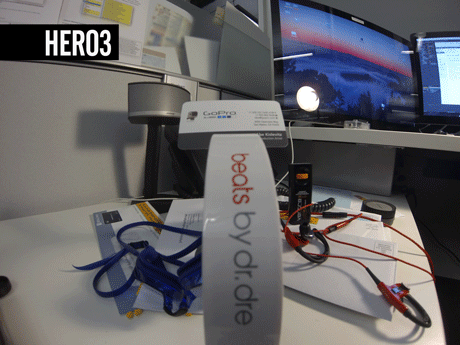Looking for a guide for a different GoPro? Check out all of my complete guides here:
Updated May 18, 2020
The GoPro HERO3+ is a solid improvement over an otherwise stunning product – the HERO3. When the HERO3 was created we poured in everything to push the boundaries of image quality and technology for a little box. The HERO3+ is built upon the same platform of the HERO3 utilizing the same sensor and processor combo. There are plenty of new great features which I will list below. When I mention HERO3+, it is assumed I am talking about the Black Edition unless otherwise noted.
New Battery & Better Battery Life
New 1180mAh battery comes stock vs the old 1050mAh, a 12% increase in overall battery capacity. Coupled with software tweaks and efficiency changes, you’ll notice a considerable increase in battery life over the HERO3.
New Faster WiFi
HERO3+ is sporting a new WiFi chipset. It’s one of the biggest practical updates you’ll experience. Using the GoPro App on an iPhone 5 the “Live Preview” is down from a full 4 seconds of lag to just under a second. If you’ve experienced the old lag, the new will actually feel almost live. Check out the video below also showcasing photo download speeds – this is huge! The same SD card is used in both the 3 and 3+. 3+ download speeds are over 4x faster. This will come in handy with possible future improvements to the app which will start enabling easy video sharing.
New Lens
Reduced Chromatic Aberration
One of the biggest improvements in the lens is the reduced CA (chromatic aberration). CA is the yellow/blue fringing you may see in photos or video up close in areas of high contrast. It happens when not all of the wavelengths of color focus at the same point, giving the appearance of blur in certain colors. Higher quality lenses have less CA. The following sample was shot in 2.7K ProTune on both cameras. See the yellow and blue/purple fringing on the edges of the windows in the detail photo below, showing a 100% full size crop of the video frames.
Distortion Profile
Distortion is difficult to measure unless you’re looking at perfect gridlines. The distortion profile is certainly slightly different than HERO3 – not necessarily better or worse. There seems to be a bit more curvature at the edges in HERO3+ which tells me there’s slightly more distortion; however, the center seems to yield a straighter horizon. These two photos were taken in identical positions inside a static single housing.
New Color Profile
Our image quality (IQ) team at GoPro has been hard at work bringing you an all new color profile for the HERO3+ that renders scenes more real than ever before. GoPro started out a few years ago with the ‘hyper-real’ colors of HD1 and HERO2, and we’ve finally stepped away from that with HERO3+. You’ll notice tones are slightly warmer than HERO3 and images have less of a fluorescent green ‘sheen’ that HERO3 tends to have. Some other things you’ll notice is better color representation in the sky, tendencies for white horizons is reduced, and more. The HERO3+ has some internal software restructuring from the ground up to give the IQ team better control over how color is processed in the camera so it’s more than a simple hue change one direction or another. Major hats off to the IQ team for delivering a stunning image in this new camera. The following are all photos straight from the camera. *Note that video modes reflect photo color very closely
New Software Features
2.7K Medium FOV
Those that know the HERO3 will know that 2.7K is one of the most stunning modes. We’ve brought the ever popular medium FOV option into 2.7K for awesome high resolution video with less distortion and more “zoom”. Remember, this isn’t a digital zoom, but a crop of the sensor. You will see slightly more noise & grain in this mode since there’s less scaling from the original sensor capture.
SuperView
So the GoPro sensor is a full 4:3 (almost square) aspect ratio, yet most video modes like 1080P are 16:9 (widescreen). This means you’re cutting off important visual data on the top and bottom of your video that could actually be captured! In the GoPro we have 4:3 modes that take care of this in the form of 1440P and 960P, but if you’re not a computer person, getting those to playback at 16:9 can be pretty confusing. Superview automatically captures a 4:3 aspect ratio (so full height, sky and feet) and dynamically stretches it to fit a 16:9 aspect ratio. It doesn’t just stretch it down, everything would look fat, but pinches the center so anything in the center of the frame looks good, while it stretches out the outsides. I explain this and how to do it manually in great detail in this post. Superview has the potential for great results as well as some pretty funky looking video. Basically anything POV without a ton of important visual items in the edges of the frame will look good – examples are motocross from the head, downhill mountain biking from the head or chest, skiing on the head or chest, surfing from the nose of the board, etc. Anything where you start interacting with people or holding it in your hand will end up with some stretchy looking figures. Bottom line for this mode is the more view you have in any of your sports the more immersive and smooth your video will be – try it out and see how you like it. If you don’t like it, you’ll know how to do it manually by filming in 1440 or 960 and using the methods I describe in “4:3 Footage Explained“. It’s actually not as weird as you think – we’ve been doing it to every POV motocross video since 2010 🙂
In the example below notice how the cars in the center of the superview frame stay at relatively the correct aspect ratio while the cars on the left and right edge are stretched out horizontally. Also take note of how much more vertical space exists in the superview frame. You can imagine if you’re skiing you’d see the horizon, the ski trail, and your skis while in regular 1080 you’d miss the horizon or the skis, or both. Take a look at the POV examples below as well – these are all shot in SuperView and are straight out of the camera. You get a sense of what kind of shots work really well for it.
Auto Low Light Mode
When auto low light mode is activated and you’re filming at a high frame rate, the camera will dynamically change frame rate on the fly within your video clip to allow for more light. If you’re in 1080-60 and it gets REALLY dark, it will switch into 1080-30 (giving all the benefits of 1080-30) but still keep the 59.94 timing. It does this by duplicating frames. I don’t know the threshold values for it to activate, but it’s usually pretty dark. Once it activates, it stays in low frame rate constantly so it’s not swapping back and forth on you. Now I know most of my readers probably say they’d never want it switching frame rates on them, which is what I initially thought as well. There have been plenty of times I’ve gone into really dark situations and I have ruined footage because it’s dark and blurry filming at 1080-60. At that point high frame rate does you nothing! That being said, I’m not a huge proponent of this mode, but for the average consumer it’s a nice to have as a ‘set it and forget it’ mode. One thing to note is the HERO3+ will not have ‘better’ low light capabilities (as in it looks better at night). This mode simply gives you the benefit of switching to a lower frame rate without having to manually change it.
New Housing
The new housing is 20% smaller and much sleeker. After using this housing for the past few months I look at the old one and laugh! It sounds funny now but the new one is awesome. The buttons are SO much easier to press. It feels quick and responsive. Also the wifi button is recessed inside the plastic so I haven’t ever hit it on accident yet. The latch is a welcome change from the burly locking enclosure from the HERO3. I’ve never had a latch bust open on HERO1 or 2, so it was surprising to see the lock on HERO3. With thinner walls, audio comes through the housing better even with a closed back door. You’ll hear more of the surfing sounds in the ocean. For now, Errorik on reddit created an awesome image gallery of the new housing so I’m going to link that here for you all!
HERO3+ Slim Housing Photos by Errorik
Redesigned Audio
I’m not a big audio guy but the original HERO3 actually had really good audio compared to previous generations. The HERO3+ continues this trend with similar audio specs only now it’s implemented AGC – Auto Gain Control. This means it’s constantly listening and adjusting the levels for what it’s picking up. I haven’t put this to the test to be honest and I’ve heard mixed reviews about AGC in DSLRs. We’ll have to see how this fares.
HERO3+ Silver vs Black
HERO3+ Silver got a big bump in specs by utilizing an all new processor that allows it to do 1080-60 and 720-120. It doesn’t have 4K-15, 2.7K, or 1440 and also doesn’t have ProTune settings. One thing I wanted to make note of is the quality difference between Black and Silver even in similar modes. As you may know from reading ‘Understanding Your New GoPro’, just because it says 1080-60 doesn’t mean the quality is the same as any other 1080-60. The quality of 1080-60 in the Black vs the Silver is quite a big difference. That said, it still is a huge leap in quality from the original Silver and looks great scaled for the web. See the example below.
As always if you have any questions, don’t hesitate to ask! Also don’t be shy helping one another out if you’ve got answers! Thanks!















